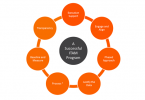ITIL® 4 is the latest version of ITIL. ITIL 4 provides a digital operating model that enables organizations to co-create effective value from their IT-supported products and services.
ITIL 4 builds on ITIL’s decades of progress, evolving established ITSM practices for the wider context of customer experience, value streams, and digital transformation. ITIL 4 also promotes greater alignment with new ways of working, such as Lean, Agile, and DevOps, to co-create business value.
ITIL 4 Guide: How to use this guide
This article introduces the BMC Blogs ITIL 4 Guide, a series of 20+ articles that walk you through the main components and activities of ITIL 4. In each article, we share our expert knowledge and hands-on experience. Use the right-hand navigation menu to move through the Guide in order or click onto the topic you need right now.
This introductory article presents the following:
- ITIL’s approach to modern service management
- An overview of the ITIL framework
- What’s new and different in ITIL 4, including the Service Value System & 4 Dimensions
- A brief history of ITIL
- Who uses ITIL
- Advantages of adopting the ITIL framework
- A sampling of other frameworks that complement ITIL
- Tips for getting started
- Links and free ebooks for further learning
Then, as you “page through” this virtual Guide, you’ll have opportunities to:
- Read in-depth, expert articles about ITIL 4
- Understand how ITIL 4 supports modern service management
- Download free ITIL guidance material
- Learn how BMC solutions are built to enable ITIL practices
- Visit the ITIL and CMDB community
Check back often to explore the BMC Service Management Blog and keep up with the latest ITIL information available from BMC.
And now… onto ITIL 4!
Download Now: ITIL 4 Best Practice e-Books
These all-new for 2020 ITIL e-books highlight important elements of ITIL 4 best practices. Quickly understand key changes and actionable concepts, written by ITIL 4 contributors.
ITIL helps organizations succeed at service management
Organizational success is largely defined by how efficiently and effectively an organization can deliver its products and services to the market, in a manner that:
- Meets customer expectations
- Beats competitor offerings
- Aligns with legal and regulatory requirements
To do this today, in the 2020s, companies must move faster to keep up with the ever-changing needs of consumers. This is particularly true in the era of social media—user preferences and options are multiplying exponentially and changing uncontrollably.
For many organizations this digital transformation also includes a shift from a product to a digital service company. This age, the “Fourth Industrial Revolution”, is characterized by the digital transformation of the world and the unavoidable interaction between humans, digital technologies, and physical assets.
How can your organization keep up with the changes in technology—while still delivering innovative, cost-effective products and services to meet the needs of your market?
You can turn to ITIL.
What is ITIL?
ITIL is a globally recognized, world-leading framework for IT service management (ITSM)—and increasingly for overall service management that delivers business value.
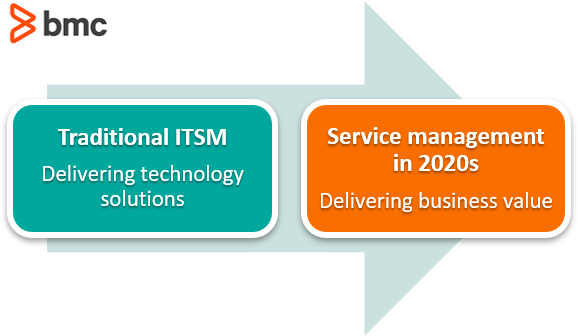
For the last 30 years, ITIL has continued to provide comprehensive, practical, and proven guidance for establishing an IT service management system, encouraging consistency and continual improvement for businesses using and delivering IT-enabled services.
For years, ITIL was shorthand for Information Technology Infrastructure Library, but that full name was eventually retired and replaced with simply ITIL. ITIL does underpin ISO20000, but there are some key differences.
ITIL has been adopted by many organizations, with millions of certified ITIL practitioners worldwide (including some who share their experience right here on BMC Blogs).
What’s new in ITIL 4?
Now in its fourth iteration, released in winter 2019, ITIL 4 provides the guidance you need to address new service management challenges and utilize the potential of modern technology in an era of cloud, Agile, DevOps, and transformation.
The key components of the ITIL 4 framework are the ITIL service value system (SVS) and the four dimensions model.
The ITIL Service Value System
The ITIL service value system provides a flexible operating model for the creation, delivery, and continual improvement of services. The core components of the ITIL SVS are:
- The ITIL service value chain
- The ITIL practices
- The ITIL guiding principles
- Governance
- Continual improvement
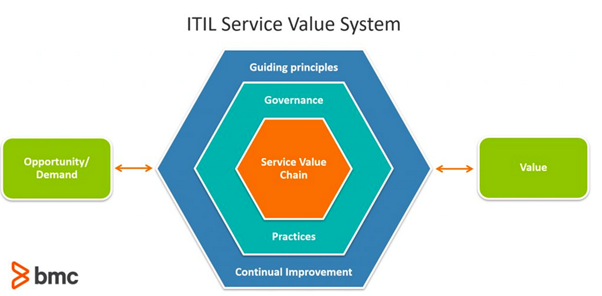
ITIL Four Dimensions
The Four Dimensions describes a balanced focus to the ITIL SVS through a holistic and effective approach. The four dimensions are:
- Organizations and People
- Information and Technology
- Partners and Suppliers
- Value Streams and Processes
These components are a significant evolution of ITIL from previous iterations. From a specific focus on delivering services to the broader perspective of the value created by the products and services delivered to the customer. ITIL 4 is designed to provide a seamless transition from an organization’s existing investment in ITIL and its current way of working, to a faster, more flexible, more agile approach.
Learn more about the differences between ITIL v3 and ITIL 4.
Who is Axelos? A brief history of ITIL
You can’t get far into ITIL without stumbling across Axelos and wondering who or what this is. Axelos owns ITIL—but ITIL predates Axelos. Here’s a brief history:
- In the late 1980s, the UK government recognized their growing dependence on technology. To standardize tech management, the government tapped the Central Computer & Telecommunications Agency (CCTA) to create process-oriented best practices.
- The first version of ITIL was based on the plan-do-check-act (PDCA) cycle.
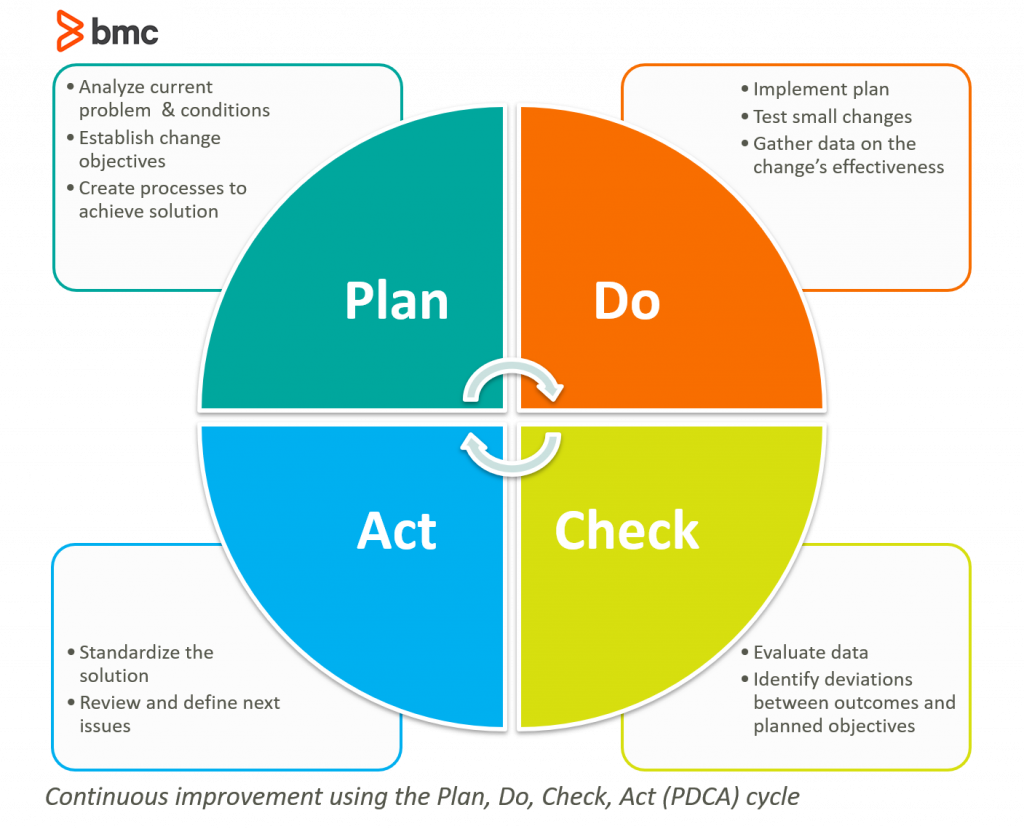
- ITIL v2 was released in 2000 and the next edition, ITIL 2007, a few years later.
- Microsoft soon began adopting ITIL v2, using it as a base for the Microsoft Operations Framework.
- In 2011, the next official update was released. ITIL v3 had five volumes: Service Strategy, Service Design, Service Transition, Service Operation, and Continual Service Improvement.
- In 2013, a joint venture between the UK Government and Capita, a consulting firm, formed Axelos in order to better develop and manage its growing Global Best Practice Portfolio.
- In February 2019, Axelos released ITIL 4, with a new focus on Agile and modern service delivery.
For the most official ITIL information, especially ITIL certification programs, head to Axelos. Axelos also owns other best practice frameworks:
- PRINCE2 for project management
- Resilia for cyber security
- AgileSHIFT for enterprise agility
- And many more!
Who uses ITIL?
Large, medium, and small organizations all over the world use ITIL to help them improve the value of their services. ITIL helps organizations in all industries and sectors to:
- Solve business issues
- Improve IT capability
- Implement new capabilities that directly provide business value
Here are just a few well-known examples of the organizations who have implemented ITIL:
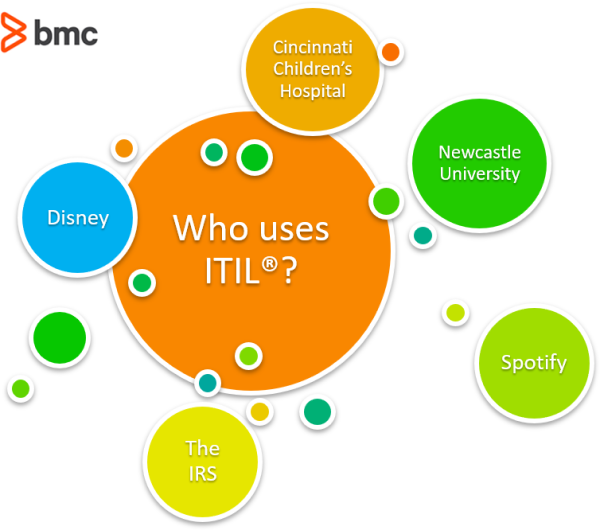
Benefits and advantages of ITIL 4
Organizational benefits of adopting ITIL 4 include:
- Faster and more flexible service delivery practices to support digital transformation
- Better strategic alignment between IT and the business
- Smoother integration between evolving software delivery practices and the enterprise customer support framework
- Improved service delivery and customer satisfaction
- Reduced costs through improved use of resources
- Greater visibility of IT costs and assets
- Better management of business risk and service disruption or failure
Frameworks that enhance ITIL
When it comes to overall business activity, ITIL is not the only framework that can be effective. While it is the most widely used and understood around the world, some of the most successful companies use a variety of frameworks and best practices alongside ITIL. This can be very effective as each approach brings something different to the mix.
Here are some other popular frameworks and concepts:
- COBIT is a leading framework specific to governance and compliance. It is much stronger than ITIL in these areas, and the two work very well together.
- Together, Agile and DevOps help to ensure the IT organization quickly delivers new business functionality. They could conflict with ITIL because of cultural differences between the people who adopt them, but they can fit together well if the organization understands the value each provides.
- Lean can be used to drive continual improvement and elimination of waste. It is a great fit with ITIL continual improvement.
Getting started with ITIL 4
Ready to get started with ITIL 4? Whether you’re brand new or already familiar with ITIL, you’re in the right spot. Browse the Guide menu, to the right, and jump to topics of interest. Remember, ITIL 4 is significantly different from its predecessors, so what you think you know about ITIL and service management might no longer be the case.
- Organizations who want (or need) to adopt ITIL practices can seek the advice of professional consultants. Implementing ITIL holistically is no small ask, so certified ITIL pros can help you learn from the mistakes of other organizations.
- Individuals who want to excel at ITIL can pursue a few levels of ITIL certifications. (Learn more in this guide and get study help for the ITIL Foundational Exam.)
If you’ve already read through the BMC Blogs ITIL 4 Guide, then you’re ready to download our FREE best practice e-books, specific to ITIL 4.
Download Now: ITIL 4 Best Practice e-Books
These all-new for 2020 ITIL e-books highlight important elements of ITIL 4 best practices. Quickly understand key changes and actionable concepts, written by ITIL 4 contributors.
BMC and ITIL: A partnership
BMC builds solutions which align fully to the ITIL framework, and supports those solutions with ITIL training, services, and resources. Our Centers of Excellence and industry-leading technologies help organizations all over the world define and execute their ITSM strategies for becoming an Autonomous Digital Enterprise.
Whether transforming or evolving service maturity, BMC has helped organizations worldwide achieve high-performing service business value. BMC helps organizations achieve value from all the ITIL process areas.
BMC also provides:
- A comprehensive set of best-in-class, PinkVerify-certified ITIL technologies
- ITIL industry contributors
- Industry-leading education offerings
- Transformation practice for ITIL prescriptive guidance
- Industry partner collaboration
- ITIL synergies with other best practices
Learn about ITSM solutions from BMC.
Additional resources
For more on ITIL 4, explore the 20+ articles in our ITIL 4 Guide (menu on right).
Studying or already certified in ITIL v3? We have you covered with our ITIL v3 Guide featuring 20 in-depth articles.
For more on ITSM generally, explore our BMC Service Management Blog and these articles:
- The State of ITSM in 2020
- ITSM vs ITIL: What’s the Difference?
- How To Build Your ITSM Business Case (Free Template Included)
ITIL® is a registered trademark of AXELOS Limited. IT Infrastructure Library® is a registered trademark of AXELOS Limited.








